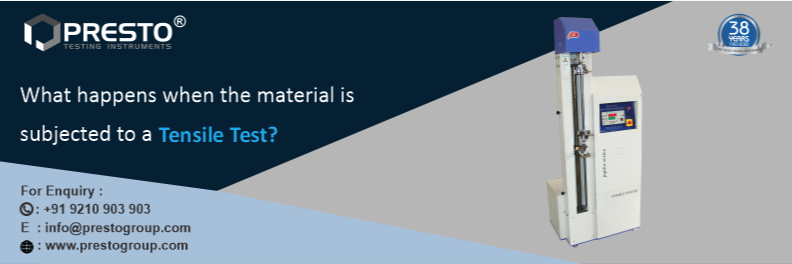

05-3-2022
The efficiency and quality of the materials used in manufacturing are critical factors that help in achieving market success. Tensile tests are used to determine a material's effectiveness and behavior when a stretching force is applied to it. These tests are carried out under ideal temperature and pressure conditions to establish the material's maximal strength or load capacity. Thus, we at Presto Testing Instruments have come up with one of the highly effective testing equipment known as tensile strength tester that will help you to test the tensile strength/breaking load capacity of the product.
Materials like Fabrics, paper, rubber, plastic films, rigid plastics, metal parts, sanitary pads, diapers, HDPE woven sack, wood, mica ply, can easily be tested with the help of this lab testing instrument. Here in this blog, we will discuss what will happen to the material when it will be subjected to a tensile test.
Tensile testing, often known as tensio testing, is one of the most fundamental mechanical tests that can be done on a material. This test is carried out by the quality heads by exerting stress on the material and measuring the material's reaction to the forces applied to it.
The material elongates as a result of the pull exerted on it. This will aid manufacturers in determining the material's strength and elongation. Failure or extreme deformation occurs when a material can no longer resist the force given to it.
Tensile test results give information about the material's mechanical properties which will further be used to assess the quality. Our digital tensile testing machine is highly recommended for evaluating the tensile strength of products and materials. The equipment is based on the Constant Rate of Traverse (CRT) principle. It is equipped with an upper jaw and a lower jaw. Between the two jaws, the test specimen is held. To determine the sample's tensile strength, the lower jaw is gradually moved. Whenever you conduct this test, then you need to prepare the testing specimen for the tensile test.
This lab testing equipment will create high tensile forces that will further be used for testing and analysis purposes. Below we have mentioned the tensile strength tester specifications and features that make it the number one choice for product manufacturers.
Tensile strength testing is a destructive test method that determines the material's tensile strength, yield strength, and ductility. It determines how much force is necessary to break a composite or plastic specimen, as well as how far the specimen stretches or elongates to reach that breaking point. Tensile testing of composites is usually done in the form of basic tension or flat-sandwich tension testing, according to industry standards such as ASTM D412 -Standard Testing, ASTM D429-73, ASTM D624 ASTM D638-01, ASTM D76, IS 13360-5-7, and IS 3400 (PART 1-1987).
Below we have listed the features you will get with the help of this lab testing equipment.
Besides these features, you will also get several other optional features like:
Optional Features:
You can easily operate the tensile testing machine with these features and technical specifications. Whenever you conduct the tensile test with the help of this lab testing equipment then you need to take care of some precautions. When you take care of these precautions, then you will get highly accurate testing results.
Now, let us focus on the effect on the specimen after conducting the tensile test.
Most materials have a linear connection with the forces applied to them during the first part of the test. Tensile tests give more information about the test material and, as a result, aid in maintaining the material's quality. They also assist in the creation of novel materials. These tests offer information on the material's mechanical characteristics. The test findings assist material providers in determining the material quality and obtaining certifications.
This destructive quality test will lead the material to break when controlled tension will be applied to it. It is used to determine the strength of a material as well as how far it can be stretched before breaking. To know how our digital tensile testing machine helps manufacturers in performing the quality test, give us a call at +919210903903 or email us at info@prestogroup.com. We will instantly provide you with the required information.
Related Blogs

Salt spray test checks corrosion resistance of materials using a salt spray chamber. Essential for quality control in coatings, metals, and finishes.

Hot Air Oven uses dry heat for sterilizing glassware and metal tools, while an Autoclave uses steam under pressure—ideal for liquids and medical items.

GSM of fabric (Grams per Square Meter) indicates fabric weight and thickness. Higher GSM means denser, heavier fabric; lower GSM means lighter, thinner fabric.